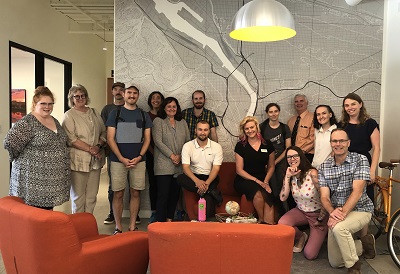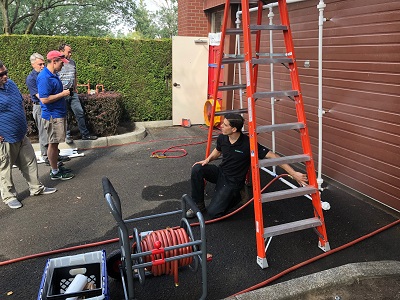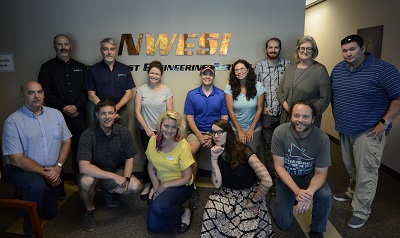Preparing students for the future workforce is a tremendous responsibility being placed upon our teachers. In order to connect classroom content to real-world context, educators need to experience and understand how professional skills and STEM knowledge are used in our region’s job sectors. Externships at STEM industries help teachers gain first-hand knowledge of how companies practice engineering design and hire for the future workforce.
Portland Metro STEM Partnership recently completed its second annual Summer Teacher Externship Program. Over fifty teachers from the Portland Metro Region visited eight local STEM-related companies representing high-wage/high-demand fields. The visits gave teachers a glimpse into the expectations, culture, and opportunities available to our region’s students.
Clean Water Services
Clean Water Services (CWS), a Water Resources Management Utility in Washington County introduced teachers to all aspects of waste and stormwater management. Our introductory talk with Human Resources set the stage for the lab, treatment plant, and Tualatin River Farm tours. Learning about the chemical, biological, an ecological underpinnings of CWS’ processes inspired teachers to make connections to their classrooms: “There are so many things that connect to my biology class! At the [Tualatin River] Farm, there were connections to many ecological concepts--especially succession.”
The Clean Water Services site tours were fascinating. At the CWS’s lab, water is tested from the treatment plant, surrounding businesses, and the Tualatin River. Chemistry teachers discovered that the tests being conducted (fecal chloroform, nitrogen levels, and ammonia) reflected the work done in their classrooms. One teacher excitedly commented: “We do this experiment!” Lab employees emphasized that this kind of work requires attention to detail, creativity, and the ability to work independently, which incited many high fives around the room.
““Seeing that my classes do some of the lab tests that are performed here will help my students see themselves as having those same skills. ”
At the Tualatin River Farm, our group learned that CWS was the first agency in the United States to be given a federal permit that allows them to accumulate temperature credits through vegetative plantings. While standing around large beds of plant starts at their farm, employees described a planting program that works from the ground up to enhance shade on the river and tributaries. This project began nearly twenty years ago and has evolved over time. For example, CWS is now looking at plants that do well further south as climate change will put different demands on cooling the river.
A treatment plant tour unfolded the process of capturing and reusing methane and producing fertilizer as a use of byproducts (available at your local Fred Meyer!). Knowing how to solve problems and stick with challenging situations were noted as critical skills by our tour guide; who commented, “Every day is a different challenge and figuring out how to use what we have to solve it is the best part of my job…”
Your Poop brought to YOU!
Special thanks to Elysia O’Connor of Clean Water Services for coordinating our 2019 teacher externship.
Davis Tool, Inc.
Davis Tool, Inc. is the largest custom manufacturing and assembling company in the Pacific Northwest. Teachers toured the machining floor and discovered that the job of a manufacturing employee requires significant math skills, independent thinking, the ability to read complex instructions unique to each project, and clear communication. There are jobs for all levels of education at Davis Tool and they specifically pull entry-level employees from Portland Community College’s Machining Program. Davis Tool is looking for employees who have hands-on experience and not just theoretical knowledge. One educator remarked that while his freshman physics curriculum has a lot of hands-on work, he would like to find ways to enhance that and incorporate more team communication.
Special thanks to Michael Stokes of Davis Tool, Inc. for coordinating our 2019 teacher externship.
Intel Corporation
Teachers approached the Intel externship with some knowledge of one of the largest employers in Oregon however most had never been inside their facilities. Part of the experience was gaining an understanding of what it’s like to be an employee at such a large company. Employees at Intel have access to onsite gyms, health clinics, coffee shops, game centers, and garden seating for cafeteria or food cart meals. Intel also has a large investment in equity and diversity. Numerous employees made time to have conversations with teachers; they represented a wide array of backgrounds and most were members of Affinity groups that provide support to specific underrepresented populations within the Intel organization.
A unique experience at Intel involved employees acting as mentors to small groups of teachers. Six employees sat at various spots in the meeting room and pairs of teachers visited each employee for a few minutes before moving onto another Intel expert. Teachers enjoyed the opportunity to ask specific questions that related to their own subject matter as well as their student demographics. Time flew by as group after groups rotated through the room.
Another surprise at Intel was the lab tour. Teachers expected to walk into a bright, white room with immaculate work stations. Instead the group found a lab that looked like a cross between an industrial garage and a computer rebuilding center. Every workstation was well-organized, but the mess of hands-on creativity along with the use of tools such as a soldering iron changed many teacher’s perceptions of lab work at Intel. Employees were moving from area to area to do work. Each was trying to work through a challenge.
Special thanks to Donna Maleki of Intel for coordinating our 2019 externship.
Oregon Health & Sciences University
The externship visit to Oregon Health & Sciences University (OHSU) was immensely popular. Teachers were excited to get a glimpse into the work that OHSU does in treating the most complex health needs in the region. While the group spoke with medical professionals with advanced degrees, our teachers were also given a unique glimpse into professions that can allow young people with other forms of post-secondary education to begin working in the field of medicine. OHSU has developed “Career Ladders” which, along with tuition reimbursement and flexible schedules, can offer a supported path to advancement.
The OHSU externship provided tours of two different departments to demonstrate how the hospital’s Career Ladders work. The Sterile Processing Lab prepares all materials for procedures and surgeries. Wearing hairnets, gloves, and bunny suits, teachers were introduced to the various jobs within the lab. Our guide explained that employees need to be able to read and put into action complex instructions regarding the materials needed for every different surgical procedure scheduled within the hospital. Employees must quickly build orders of hundreds of items from prepared sterilized instruments using codes. If one instrument is incorrect, the surgery will have to be cancelled. Other employees test the quality of reusable equipment, run instruments through sterilization chambers, and stock the hundreds and hundreds of bins with clean supplies. One sterilization technician commented that she enjoys her job because, “My work is important. People come to the hospital and the work I do directly affects their lives.”
The Sterile Processing Lab’s career ladder begins with entry-level employees who have high school diplomas/GEDs with one year’s work experience. Successful applicants have to be able to read precise instructions and work carefully and quickly. The pathway to advancement as technicians, senior technicians, and managers is clearly laid out. The lab also encourages further education through tuition reimbursement and flexible scheduling. Many people move on to become members of different departments at the hospital.
Hospital Transportation was the second tour for the educators. Employees in Transportation move patients from ambulances to Emergency to every other test, room or exam necessary. These Patient Transportation Techs are able to start work with their high school diploma. The department gives a 2-week training and encourages techs to access the educational resources at OHSU. Schedules can be worked around these classes. Especially since this work involves interfacing with people experiencing trauma, severe injury, and even death, this job is a good place to find out if a healthcare career with lots of patient interaction will work for an individual.
Employees usually stay less than 18 months because it is a jumping off point to more advanced careers at OHSU. A common refrain at OHSU was that it’s important to get your foot in the door and work hard, then the Career Ladders will move you to where you want to be.
Special thanks to Susan Shugerman of OHSU for coordinating our 2019 externship.
Pacific Northwest Carpenters Institute
Pacific Northwest Carpenters Institute is a premier educational institution in Portland that provides apprenticeship and journeyman skill advancement training for many construction trades. In addition to employment opportunities and hiring demands, this externship offered teachers a unique opportunity to take part in a standard lesson for apprentice carpenters beginning their training. Teachers were paired up and asked to measure and draw chalk lines for a structure consisting of three rooms. The teacher pairs needed to account for wall cavity space as well as an arched doorway to a “room” too small to lay out compass points and draw a circle that could model the arch to scale. Teachers found themselves using fairly rusty math skills, an incredibly sophisticated carpenter’s calculator, and much trial and error. The difficulty of the exercise made clear the advanced math and engineering expertise used in this profession.
Special thanks to Meg Kilmer of PNCI for coordinating our 2019 externship.
Kittleson & Associates, Inc.
One of the nation’s leading Transportation Agencies, Kittleson & Associates, Inc. opened its doors to teachers for the second year in a row this summer. Educators were greeted by both the agency founder and it’s incoming CEO. Both shared the history of Kittleson, the philosophy that drives their company’s success, and the traits they look for in prospective employees. The importance of being brave and having the willingness to fail came up again and again. Educators met with different project groups and learned how teams function together to develop designs, work with construction companies, inform communities, and manage city and state regulations. One teacher remarked, “Trust! Most employees said the word trust. The company trusts the employees and the employees trust the company.” The culture at Kittleson is one of flexibility and freedom with the expectation that everyone will do their part.
Special thanks to Krista Purser of Kittleson & Associates for coordinating our 2019 externship.
NorthWest Engineering Service Inc.
NorthWest Engineering Service Inc. was formed when it became apparent that heating and ventilation had become so complex, engineers were needed “in the trenches”, taking hands-on measurements and making adjustments, to ensure systems were properly balanced. Teachers here were greeted with enthusiasm by the company president who gave an overview of what HVAC systems are and how these engineers and technicians carry out their work. Additionally employees spoke about their passion for this work including the hands-on aspects and importance of solving complex problems with their colleagues. A female technician highlighted the emphasis on diversity and inclusivity at NWESI as well as how being at an entirely employee-owned business increased her desire to work with drive and commitment.
Special thanks to Tom Prevish of NWESI for coordinating our 2019 externship.
Timbercon, Inc.
The Timbercon, Inc. externship gave educators an opportunity to see first-hand the work involved in designing and manufacturing fiber optic and hybrid cables to meet specific customer needs. Teachers learned about the opportunity and value of working at a small company (Timbercon has 70 employees). The VP of People drew a comparison between living in a small town versus a large city. In a small town, a person might make a living as a business owner but also serve as a volunteer firefighter or develop community initiatives that impact the whole town. Individuals in larger cities; however, are not often afforded these opportunities. Because of Timbercon’s smaller has an opportunity to impact more than just the scope of her job. In fact, Timbercon looks to hire people with broad awareness of how they can add value to the company. The VP explained that while technical knowledge is necessary, traits like willingness to take risks, be creative, and collaborate will determine whether a candidate is hired.
Special thanks to Laura McKinney of Timbercon for coordinating our 2019 externship.
2019’s Summer Teacher Externships took the model from last summer and expanded it from two externship sites to eight and from twenty teachers to fifty. This year, teachers were also able to attend multiple business sites. The result was a much more connected awareness of skills and expectations of employees in all job sectors. Every business shared the importance of an employee’s ability to communicate well, collaborate with colleagues, think creatively, and take risks. One teacher noted that “students need to know how to work together and use each other as resources. They need to know how to problem solve and think creatively.”
Many educators commented on the many STEM jobs available for all levels of post-secondary education from paid apprenticeships to engineers with PhDs. They were excited to learn how many companies partner with local educational institutions to bring in new employees. All of our educators walked away with plans to build their new knowledge into student work.
For more information, connect with Priscilla.Lundberg
















